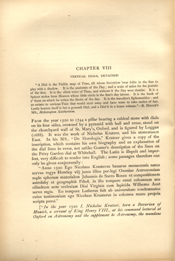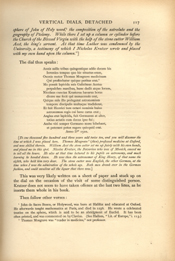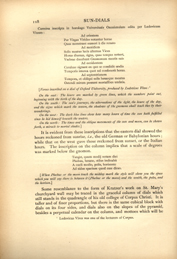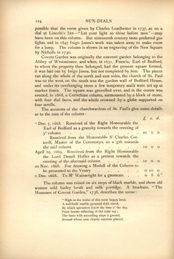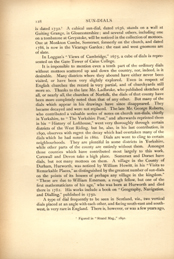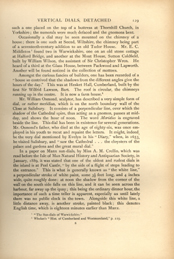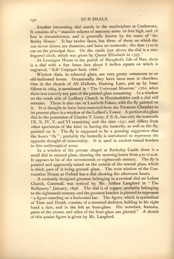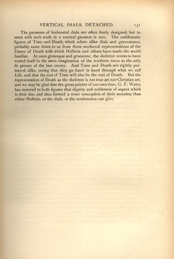CHAPTER VIII
VERTICAL DIALS, DETACHED
"A Dial is the Visible map of Time, till whose Invention 'twas follie in the Sun to play with a shadow. It is the anatomie of the Day; and a scale of miles for the journie of the Sun. It is the silent voice of Time, and without it the Day were dumbe. It is a Spheer stolen from Heaven whose little circle is the Sun's day labour. It is the book of ye Sunn on which he writes the Storie of the day. It is the traveller's Ephemerides: and an enimie to envious Time that would steal away and have none to take notice of her. Lastly heaven itself is but a generall Dial, and a Dial it in a lesser volume." — R. HEGGE'S MS., Heliotropum Sciothericum.
FROM the year 1520 to 1744 a pillar bearing a cubical stone with dials on its four sides, crowned by a pyramid with ball and cross, stood on the churchyard wall of St. Mary's, Oxford, and is figured by Loggan (1688). It was the work of Nicholas Kratzer, and his stonemason East. In his MS., "De Horologis," Kratzer gives a copy of the inscription, which contains his own biography and an explanation of the dial lines in verse, not unlike Gunter's description of the lines on the Privy Garden dial at Whitehall. The Latin is illspelt and imperfect, very difficult to render into English; some passages therefore can only be given conjecturally:
"Anno 1520 Ego Nicolaus Krasterus bauarus monacensis natus servus regys Henricy viij jussu illius per-legi Oxoniae Astronomiam suple spheram materialem Johannis de Sacro Bosco et compositionem astrolaby et geographiā Pthoƚ, in illo tempore erexi columnam seu cilindrum ante ecclesiam Diui Virginis cum lapicida Wilhelmo Aest servo regis. Eo tempore Lutherus fuit ab universitate condemnatus cuius testimonium ego Nicolaus Krasterus in columna manu propria scripta posui."
[In the year 1520 I, Nicholas Kratzer, born a Bavarian of Munich, a servant of King Henry VIII., at his command lectured at Oxford on Astronomy and the supplement to Astronomy, the mundane
sphere of John of Holy wood, 1 the composition of the astrolabe and the geography of Ptolemy. While there I set up a column or cylinder before the Church of the Blessed Virgin with the help of the stone cutter William Aest, the king's servant. At that time Luther was condemned by the University, a testimony of which I Nicholas Kratzer wrote and placed with my own hand upon the column."]
The dial thus speaks:
Annis mille tribus quingentique adde decem bis
Invenies tempus quo hic situatus eram,
Oxonie rector Thomas Mosgrave medicinam
Qui profitebatur quique peritus erat. 2
Me posuit lapicida suis Gulielmus Aestus
perpulchre manibus, hunc dedit atque locum,
Nicolaus cunctas Krasterus bavarus horas
dicere me fecit qui monacensis erat,
Quique suis illo prelegerat astronomiam
tempore discipulis multaque tradiderat,
Et fuit Henrici tum octavi nominis huius
astronomus regis cui bene carus erat;
Anglus erat lapicida, fuit Germanus at alter,
totius aetatis cum decus ipse fui;
Ambo viri semper Germano more bibebant,
et poterant potus sugere quicquid erat.
Anno Dni 1520.
[To one thousand five hundred and three years add twice ten, and you will discover the time at which I was placed here. Thomas Mosgrave 2 (then) professed medicine at Oxford, and was skilled therein. William Aest the stone cutter set me up fairly with his own hands, and placed me in this spot. Nicolas Kratzer, the Bavarian who was of Munich, caused me to tell all the hours. He also at that time lectured to his pupils on astronomy, and much learning he handed down. He was then the astronomer of King Henry, of that name the eighth, who held him very dear. The stone cutter was English, the other German, at the time when I was the admiration of the whole age. Both men drank ever in the German fashion, and could swallow all the liquor that there was.]
This was likely written on a sheet of paper and stuck up on the dial on the occasion of the visit of some distinguished person. Kratzer does not seem to have taken offence at the last two lines, as he inserts them whole in his book.
Then follow other verses:
1 John de Sacro Bosco, or Holywood, was born at Halifax and educated at Oxford. He afterwards taught mathematics at Paris, and died in 1256. He wrote a celebrated treatise on the sphere, which is said to be an abridgment of Euclid. It has been often printed, and was commented on by Clavius. (See Hallam, "Lit. of Europe," i. 113.)
2 Thomas Mosgrave was "reader in medicine," not professor.
Carmina inscripta in horologo Vniversitatis Oxoniensium edita per Ludovicum Viuum:
Ad orientem
Per Virgas Virides notantur horae
Quas monstrant numeri à die renato
Ad meridiem
Solis meatus lucis alternas Vices
Horas diurnas, signa, quae tempus notant,
Vmbrae docebunt Gnomonum meatis suis
Ad occidentem
Ceruleae signant ex quo se condidit undis
Temporis interea quot sol confecerit horas.
Ad septentrionem
Tempora, et obliqui solis lunaeque meatus
Ostendi mirum possunt mortalibus umbris.
[Verses inscribed on a dial of Oxford University, produced by Ludovicus Vives: 1
On the east: The hours are marked by green lines, which the numbers point out, beginning with the birth of the day.
On the south: The sun's journeys, the alternations of the light, the hours of the day, and the signs which mark the season, the shadows of the gnomons shall teach thee by their wanderings.
On the west: The dark blue lines show how many hours of time the sun hath fulfilled since he hid himself beneath the waters.
On the north: The times and the oblique movements of the sun and moon, can be shown forth, a miracle to mortal shades.]
It is evident from these inscriptions that the eastern dial showed the hours reckoned from sunrise, i.e., the old German or Babylonian hours; while that on the west gave those reckoned from sunset, or the Italian hours. The inscription on the column implies that a scale of degrees was marked below the gnomon.
Tanget, quum medij notam diei
Phebus, lunane, stilus indicabit
A coeli medio, polis, horizonte
Ad sidus spacium quod esse dices.
[When Phœbus or the moon touch the midday mark the style will show you the space which you will say there is between it (Phœbus or the moon) and the zenith, the poles, and the horizon.]
Some resemblance to the form of Kratzer's work on St. Mary's churchyard wall may be traced in the graceful column of dials which still stands in the quadrangle of his old college of Corpus Christi. It is taller and of finer proportions, but there is the same cubical block with dials on its four sides, and dials also on the slopes of the pyramid, besides a perpetual calendar on the column, and mottoes which will be
1 Ludovicus Vives was one of the lecturers of Corpus.

[Full Image]
CORPUS CHRISTI COLLEGE, OXFORD.
found later on in this book. The date 1581 is on the south face, and the initials C. T. and the date MDCV on the column.
The initials are those of Charles Turnbull, a Lincolnshire man, by whom these dials were constructed. He was admitted to the college in 1573, and was the author of a treatise on the Celestial Globe. The first date probably applies to the setting up of the dials, and the second to the tables which are painted on the cylindrical shaft. Hegge gives a drawing of the dial as it appeared in his time, 1625-30, and this has been reproduced in Mr. Fowler's "History of Corpus Christi College." The shaft then rested on steps, which the present square pedestal afterwards replaced. The vertical dials were partly covered by the coat-of-arms, carved in relief, of (1) Bishop Fox, the founder of the college; (2) Bishop Oldham; (3) the University of Oxford; and (4) also by the Royal arms. In each case the scrollwork round the shield acts as a gnomon to the dial face engraved below it. The column is said to have been regarded as "inconvenient" during the old days when invasion was threatened, and the quadrangle was used as a drill ground, but happily it was not removed from its place, and still stands as a monument of Turnbull's mathematical skill.
Few sun-dials are of greater historical interest than that which bears the name of the celebrated Anne Clifford, Countess of Pembroke, the able and excellent lady who could discourse on every subject, "from predestination to slea' silk," the heiress of the great house of Clifford, who fought in the courts for her vast estates with the tenacity and ruled them with the wisdom of a Maria Theresa; raising also her castles from
their ruins, repairing the churches, building again, as the inscriptions state, the old waste places. Amongst the monuments reared by her, this pillar by the wayside between Brougham and Appleby still stands to record her name,. It is octagonal, and surmounted by a square block bearing dials on two of its sides; on the other two are the arms of the Viponts, from whom the estate of Brougham came to the Cliffords, and those of Clifford impaling Russell, surmounted by an earl's coronet. There is also the following inscription:
THIS PILLAR WAS ERECTED, ANNO 1656,
BY THE RIGHT HON. ANN COUNTESS DOWAGER OF
PEMBROKE, AND SOLE HEIR OF THE RIGHT
HONOURABLE GEORGE, EARL OF CUMBERLAND ETC.,
FOR A MEMORIAL OF HER LAST PARTING IN THIS PLACE.
WITH HER GOOD AND PIOUS MOTHER, THE RIGHT HONOURABLE
MARGARET COUNTESS DOWAGER OF CUMBERLAND,
THE SECOND OF APRIL, 1616. IN MEMORY WHEREOF
SHE ALSO LEFT AN ANNUITY OF FOUR POUNDS
TO BE DISTRIBUTED TO THE POOR WITHIN THIS
PARISH OF BROUGHAM, EVERY SECOND DAY OF APRIL
FOR EVER UPON THIS STONE TABLE.
LAUS DEO.
The stone table for the alms stands at the foot of the pillar. Another dial pillar set up by the Countess at Appleby is noticed in the motto collection.
For some part of the eighteenth century the base of the High Cross in Warwickshire bore a conical sun-dial crowned by a vase and cross. It marks the place where the old Roman fosse-way crossed Watling Street, and is locally called the "centre of England." The dial was struck down by lightning in 1791, and only the base of the cross remains. This bears two Latin inscriptions written by George Greenaway, a schoolmaster at Coventry, one to draw attention to the Roman roads and castra, and the other in praise of the Earl of Denbigh, by whose care the column was erected A.D. 1722.
Of another dial-stone only the memory remains. This was a square pillar 12 ½ feet high, which stood in the hamlet of Three Mile Bridge near Newcastle-on-Tyne. It was erected by John Pigg, town surveyor of Newcastle during the Civil Wars, who walked daily from his house in the town to Three Mile Bridge, and derived so much health and pleasure from the habit that he put up a lasting monument of his
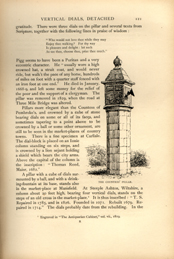
[Full Image]
THE COUNTESS' PILLAR.
gratitude. There were three dials on the pillar and several texts from Scripture, together with the following lines in praise of wisdom:
"Who would not love thee while they may
Enjoy thee walking? For thy way
Is pleasure and delight: let such
As see thee, choose thee, prize thee much."
Pigg seems to have been a Puritan and a very eccentric character. He "usually wore a high crowned hat, a strait coat, and would never ride, but walk't the pace of any horse, hundreds of miles on foot with a quarter staff fenced with an iron foot at one end." He died in January, 1668-9, and left some money for the relief of the poor and the support of a clergyman. The pillar was removed in 1829, when the road at Three Mile Bridge was altered.
Pillars more elegant than the Countess of Pembroke's, and crowned by a cube of stone bearing dials on some or all of its faces, and sometimes tapering to a point above to be crowned by a ball or some other ornament, are still to be seen in the market-places of country towns. There is a fine specimen at Carlisle. The dial-block is placed on an Ionic column standing on six steps, and is crowned by a lion sejant holding a shield which bears the city arms. Above the capital of the column is the inscription: "Thomas Reed, Maior, 1682."
A pillar with a cube of dials sumounted by a ball, and with a drinking-fountain at its base, stands also in the market-place at Mansfield. At Steeple Ashton, Wiltshire, a column about 20 feet high, bearing four vertical dials, stands on the steps of an old cross in the market-place. 1 It is thus inscribed: "T.S. Repaired in 1785, and in 1826. Founded in 1071. Rebuilt 1679. Repaired in 1714." The dials probably date from the rebuilding. In the
1 Engraved in "The Antiquarian Cabinet," vol. vii., 1819.
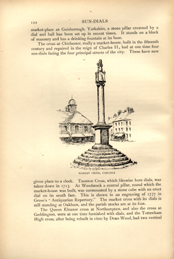
[Full Image]
MARKET CROSS, CARLISLE.
market-place at Guisborough, Yorkshire, a stone pillar crowned by a dial and ball has been set up in recent times. It stands on a block of masonry and has a drinking fountain at its base.
The cross at Chichester, really a market-house, built in the fifteenth century and repaired in the reign of Charles II, had at one time four sun-dials facing the four principal streets of the city. These have now given place to a clock. Taunton Cross, which likewise bore dials, was taken down in 1715. At Woodstock a central pillar, round which the market-house was built, was surmounted by a stone cube with an erect dial on its south face. This is shown in an engraving of 1777 in Grose's "Antiquarian Repertory." The market cross with its dials is still standing at Oakham, and the parish stocks are at its foot.
The Queen Eleanor cross at Northampton, and also the cross at Geddington, were at one time furnished with dials, and the Tottenham High cross, after being rebuilt in 1600 by Dean Wood, had two vertical

[Full Image]
ASHLEWORTH CHURCHYARD.
dials placed on its south and west sides, one of which remained till 1809.
But how many dial-pillars stand on the bases of ancient crosses in market-places, churchyards, or by the wayside, it were hard to say. The old wayside cross at Culmerden, Gloucestershire, has a dial-block mounted on an Early English shaft. At Ashleworth, in the same county, the shaft of a former churchyard cross, 5 feet high, now supports a block of dials, those on the east and west sides being hollowed. One in Ilam Churchyard, Derbyshire, was sketched for the Anastatic Drawing Society in 1860; another is at Biddulph, in Staffordshire, and is thought to date from the sixteenth century. At Martock, Somerset, a tall fluted column, surmounted by a cube with four dials, a ball, and vane, stands on an ancient base; and at Backwell, Kenn, Queen's Charlton, and Chelvey, in the same county, as well as at Saintsbury, Gloucestershire, these picturesque monuments are still, we trust, to be found. A modern dial-block of this type, mounted on a pillar, was set up some thirty years ago at Henbury, Gloucstershire. It has a drinking fountain at its base, and is a great ornament to the village.
Mr. E. C. Middleton 1 has noticed a fine old cross shaft, with a cube of four dials, crowned by a ball, at Whatcote, Warwickshire, and others at Chaddesley Corbett, Worcestershire, and Congleton in Cheshire. At Packwood House, Warwickshire, there are no less than seven dials (two of which will be found noticed in the collection of mottoes). In front of the house, an old shaft on steps bears a cubical block with four dials, dated 1667; and there is a curious stone seat in the garden made of a square block, which has evidently borne gnomons.
London possessed at least three specimens of this class of dial-pillar. There was a column in New Square, Lincoln's Inn, with four vertical dials, surmounted by a pinnacle, said to have been designed by Inigo Jones. Like Sir John Dethick's dial in Leadenhall Street, it formed the centre of a fountain; the water spouted forth from shells held by four tritons, and fell into a basin at the foot of the column. It is
1 "The Sundials of Warwickshire," 1896.
possible that the verse given by Charles Leadbetter in 1737, as on a dial at Lincoln's Inn — "Let your light so shine before men" — may have been on this column. But nineteenth century taste preferred gas lights, and in 1847 Inigo Jones's work was taken away to make room for a lamp. The column is shown in an engraving of the New Square by Nicholls in 1730.
Covent Garden was originally the convent garden belonging to the Abbey of Westminster, and when, in 1631, Francis, Earl of Bedford, to whom the property then belonged, had the present square formed, it was laid out by Inigo Jones, but not completed by him. The piazza ran along the whole of the north and east sides, the church of St. Paul was on the west, on the south was the garden wall of Bedford House, and under its overhanging trees a few temporary stalls were set up at market times. The square was gravelled over, and in the centre was erected, in 1668, a Corinthian column, surmounted by a block of stone, with four dial faces, and the whole crowned by a globe supported on four scrolls.
The accounts of the churchwardens of St. Paul's give some details as to the cost of the column:
| £ | s. | d. | ||
| Dec. 7 1668. | Received of the Right Honourable the Earl of Bedford as a gratuity towards the erecting of ye column | 20 | 0 | 0 |
| Received from the Honourable Sr Charles Cotterill, Master of the Ceremonys, as a gift towards the said column | 10 | 0 | 0 | |
| April 29, 1669. | Received from the Right Honourable the Lord Denzil Holles as a present towards the erecting of the aforesaid column | 10 | 0 | 0 |
| 20 Nov. 1668. | For drawing a Modell of the Column to be presented to the Vestry | 0 | 10 | 0 |
| 2 Dec. 1668. | To Mr Wainwright for 4 gnomons | 0 | 8 | 6 |
The column was raised on six steps of black marble, and there old women sold barley broth and milk porridge. A brochure, "The Humours of Covent Garden," 1738, describes the scene:
"High in the midst of this most happy land,
A well-built marble pyramid doth stand,
By which spectators know the time o' the day,
From beams reflecting of the solar ray;
The basis with ascending steps is graced,
Around whose area cleanly matrons placed,
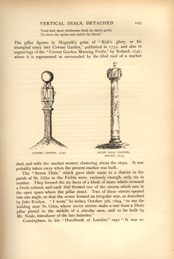
[Full Image]
COVENT GARDEN, 1747.
SEVEN DIALS COLUMN BEFORE 1773.
Vend their most wholesome food, by nature good,
To cheer the spirits and enrich the blood."
The pillar figures in Hogarth's print of "Rich's glory, or his triumphal entry into Covent Garden," published in 1732, and also in engravings of the "Covent Garden Morning Frolic," by Boitard, 1747, where it is represented as surrounded by the tiled roof of a market shed, and with the market women clustering about the steps. It was probably taken away when the present market was built.
The "Seven Dials" which gave their name to a district in the parish of St. Giles in the Fields, were, curiously enough, only six in number. They formed the six faces of a block of stone which crowned a Doric column, and each dial fronted one of the streets which met in the open space where the pillar stood. Two of these streets opened into one angle, so that the seven formed an irregular star, as described by John Evelyn. "I went," he writes, October 5th, 1694, "to see the building near St. Giles, where seven streets make a star from a Doric pillar placed in the middle of a circular area, said to be built by Mr. Neale, introducer of the late lotteries."
Cunningham, in his "Handbook of London," says "It was re-

[Full Image]
Stone formerly the "Seven Dials". Weybridge, 1864.
moved in July, 1773, on the supposition that a considerable sum of money was lodged at the base. But the search was ineffectual." The old column spent some time in a stone mason's yard, and in 1822 was bought by the inhabitants of Weybridge and set up on the Green as a memorial to the Duchess of York.
It is mounted on a square base and crowned by a very inartistic object; a ducal coronet; while the block of stone which formed the six dials, and in which the holes filled with the lead which had fastened the gnomons can still be seen, lies embedded in the ground near the neighbouring "Ship" Inn, after having been used for many years as a mounting-block.
In Gay's "Trivia" we read:
"Where famed St. Giles' ancient limits spread,
An in-railed column rears its lofty head:
Here to seven streets seven dials count the day,
And from each other catch the circling ray:
How oft the peasant with enquiring face,
Bewilder'd trudges on from place to place:
He dwells on every sign with stupid gaze,
Enters the narrow alley's doubtful maze,
Tries every winding court and street in vain,
And doubles o'er his weary steps again."
There must have been many vertical sun-dials attached to buildings in London, in former days, besides those which have been noticed with mottoes. A print of 1725 shows one on the wall of Coney Court, Gray's Inn, and another engraving of 1715, gives two on the tower of St. Clement Danes, one of which remains to this day. The old church of St. Martin in the Fields, pulled down and rebuilt around 1721, had a dial on the west, and another on the south side of the tower. St. Dunstan's, Stepney, had also a dial. That on St. Sepulchre's, Newgate, still remains, as does the one on the great hall of the Charterhouse. An old print of the Guildhall shows dials on the cupola. It is supposed that they were placed there at the end of the seventeenth or beginning of the eighteenth century. Another dial appears on one of the buttresses in the same engraving.
A very handsome dial stands in the Earl of Derby's park at Knowlsey. The cube is mounted on a spiral pedestal with a base of three steps, supported by four eagles. The dials face the four points of
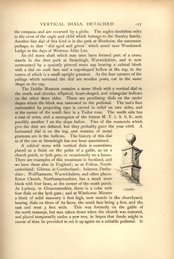
[Full Image]
LYDNEY.
the compass, and are crowned by a globe. The eagles doubtless refer to the crest of the eagle and child which belongs to the Stanley family. Another fine dial of this kind is in the park at Blenheim, the successor, perhaps, to that "dial aged and green" which stood near Woodstock Lodge in the days of Mistress Alice Lee.
An old stone shaft which may once have formed part of a cross, stands in the deer park at Stoneleigh, Warwickshire, and is now surmounted by a quaintly pierced stone cap bearing a cubical block with a dial on each face and a cup-shaped hollow at the top, in the centre of which is a small upright gnomon. At the four corners of the palings which surround the dial are wooden posts, cut in the same shape as the cap.
The Dublin Museum contains a stone block with a vertical dial to the south, and circular, elliptical, heart-shaped, and triangular hollows on the other three sides. There are proclining dials on the under slopes where the block was narrowed to the pedestal. The sun's face surrounded by projecting rays is carved in relief on two sides, and at the corner of the south face is a Tudor rose. The north side has a coat of arms, and a monogram of the letters M.T.I.S.S.B., with possibly another I on the slope below. Two of the numerals which give the date are defaced, but they probably gave the year 1688. A horizontal dial is on the top, and remains of metal gnomons are in the hollows. The history of this dial as of the one at Stoneleigh has not been ascertained.
A cubical stone with vertical dials is sometimes placed as a finial on the point of a gable, as on a church porch, or lych gate, or occasionally on a house. There are examples of this treatment in Scotland, and we have them also in England; as at Felton, Northumberland; Gilcrux, in Cumberland; Ashover, Derbyshire; Wolfhamcote, Warwickshire, and other places. Ecton Church, Northhamptonshire, has a much worn block with four faces, at the corner of the south porch. At Lydney, in Gloucestershire, there is a cube with four dials on the lych gate; and at Wimborne Minster a block of solid masonry 6 feet high, now stands in the churchyard, bearing dials on three of its faces, the south face being 4 feet, and the east and west 3 feet wide. This was formerly on the gable of the north transept, but was taken down when the church was restored, and placed temporarily under a yew tree, in hopes that funds might in course of time be provided to set it up again on a suitable pedestal. It
is dated 1732. 1 A cubical sun-dial, dated 1636, stands on a wall at Guiting Grange, in Gloucestershire; and several others, including one on a tombstone at Greystoke, will be noticed in the collection of mottoes. One at Monkton Combe, Somerset, formerly on the church, and dated 1786, is now in the Vicarage Garden; the east and west gnomons are of slate.
In Loggan's "Views of Cambridge," 1675, a cube of dials is represented on the Gate Tower of Caius College.
It is impossible to mention even a tenth part of the ordinary dials without mottoes scattered up and down the country, nor, indeed, it is desirable. Many districts where they abound have either never been visited, or have been very slightly explored. Even in respect of English churches the record is very partial, and of churchyards still more so. Thanks to the late Mr. Ladbroke, who published sketches of all, or nearly all, the churches of Norfolk, the dials of that county have been more completely noted than that of any other. But many of the dials which appear in his drawings have since disappeared. They became decayed and were not replaced. The late Mr. George Roberts, who contributed a valuable series of notes on church sun-dials, chiefly in Yorkshire, to "The Yorkshire Post," and afterwards reprinted them in his "History of Lofthouse," went very thoroughly through certain districts of the West Riding, but he, also, in his last contribution, in 1890, observes with regret the decay which had overtaken many of the dials which he had noted in 1860. Dials are wont to cling to certain neighbourhoods. They are plentiful in some districts in Yorkshire, while other parts of the county are entirely without them. Amongst those counties which have contributed most largely to this work, Cornwall and Devon take a high place. Somerset and Dorset have dials, but not many mottoes on them. A village in the County of Durham, Hurworth, was noticed by William Howitt, in his "Visits to Remarkable Places," as distinguished by the greatest number of sun-dials on the points of its houses of perhaps any village in the kingdom. "These are due to William Emerson, a rough fellow, but one of the first mathematicians of his age," who was born at Hurworth and died there in 1782. His works include a book on "Geography, Navigation, and Dialling," published in 1750.
A type of dial frequently to be seen in Scotland, viz., two vertical dials placed at an angle with each other, and facing south-east and south-west, is very rare in England. There is, however, or was a few years ago,
1 Figured in "Strand Mag.," 1892.
such a one placed on the top of a buttress at Thornhill Church, in Yorkshire; the numerals were much defaced and the gnomons bent.
Occasionally a dial may be seen mounted on the chimney of a house; there is one such at Seend, Wiltshire, the chimney being part of a seventeenth-century addition to an old Tudor House. Mr. E. C. Middleton 1 found two in Warwickshire, one on an old stone cottage at Halford Bridge, and another at the Moat House, Sutton Coldfield, built by William Wilson, the assistant of Sir Christopher Wren. He heard of a third at the Glass House, between Packwood and Lapworth. Another will be found noticed in the collection of mottoes.
Amongst the curious fancies of builders, one has been recorded of a "house so contrived that the shadows from the different angles give the hours of the day." This was at Hesket Hall, Cumberland, built by the first Sir Wilfrid Lawson, Bart. The roof is circular, the chimneys running up the centre. It is now a farm house. 2
Mr. William Osmond, sculptor, has described a very simple form of dial, or rather meridian, which is on the north boundary wall of the Close at Salisbury. It consists of a perpendicular line, over which the shadow of the Cathedral spire, thus acting as a gnomon, passes at mid-day, and shows the hour of noon. The word Meridies is engraved beside the line. This dial has been in existence for several generations. Mr. Osmond's father, who died at the age of eighty-six, was once employed in his youth to recut and repaint the letters. It might, indeed, be the very dial mentioned by Evelyn in his "Diary," when, in 1653, he visited Salisbury, and "saw the Cathedral. . . the cloysters of the palace and gardens and the great mural dial."
In a paper on Manx sun-dials, by Miss A. M. Crellin, which was read before the Isle of Man Natural History and Antiquarian Society, in January, 1889, it was stated that one of the oldest and rudest dials in the island is at Peel Castle, "by the side of a flight of steps leading to the entrance." This is what is generally known as "the white line," a perpendicular stroke of white paint, some 3 ½ feet long, and 4 inches wide, quite roughly done; at noon the shadow from the corner of the wall on the south side falls on this line, and it can be seen across the harbour, far away up the quay; this being the ordinary dinner hour, the importance of such a time teller is apparent, especially as until lately there was no public clock in the town. Alongside this white line, a little distance away, is another stroke, painted black; this denotes English time, which is eighteen minutes earlier than Manx.
1 "The Sun-dials of Warwickshire."
2 Whelan's "Hist. of Cumberland and Westmoreland," p. 225.
Another interesting dial stands in the marketplace at Castletown. It consists of a "massive column of masonry some 16 feet high, and 18 feet in circumference, and is generally known by the name of 'the Babby House.' It has twelve faces, but three of them, on which the sun never shines, are dummies, and have no numerals; the date 1720 is cut on the principal face. On the castle just above the dial is a one-fingered clock, which was given by Queen Elizabeth in 1597."
At Lewaigue House in the parish of Maughold, Isle of Man, there is a dial with a fine brass face about 8 inches square on which is engraved, "Edm Culpeper fecit, 1666."
Window dials, in coloured glass, are very pretty ornaments to an old-fashioned house. Occasionally they have been seen in churches. One in the church of All Hallows, Staining Lane, put up by Isaac Oliver in 1664, is mentioned in "The Universal Museum," 1762, when there was scarcely any part of the painted glass remaining. In a window on the south side of Ledbury Church in Herefordshire such a dial still remains. There is also one at Lambeth Palace, with the fly painted on it. It is thought to have been removed from the Presence Chamber to its present place in a window of the Lollard's Tower. A portion of a glass dial in the possession of Charles T. Gatty, F.S.A., has only the numerals IX, X, IV, V, and VI remaining and the date 1741, and differs from other specimens of the kind in having the butterfly, as well as the fly, painted on it. The fly is supposed to be a punning suggestion that the hours "fly"; probably the butterfly is introduced to represent the opposite thought of immortality. It is used in ancient missal borders in this emblematical sense.
In a window of the private chapel at Berkeley Castle there is a small dial in stained glass, showing the morning hours from 4 to 10 a.m. It appears to be of the seventeenth or eighteenth century. The fly is painted and apparently raised on the outside of the central glass, which is thick, part of it being ground glass. The west window of the Convocation House at Oxford has a dial showing the afternoon hours.
A curiously designed gnomon belonging to a vertical dial on Lelant Church, Cornwall, was noticed by Mr. Arthur Langford in "The Reliquary," January, 1898. The dial is of copper, probably belonging to the eighteenth century, and the gnomon bracket is pierced to represent "a figure standing on a horizontal bar. The figure, which is symbolical of Time and Death, consists of a crowned skeleton, holding in his right hand a dart, and in the left an hour-glass. His vertebræ, features, parts of the crown, and sides of the hour-glass are pierced." A sketch of this quaint figure is given by Mr. Langford.
The gnomons of horizontal dials are often finely designed, but to meet with such work in a vertical gnomon is rare. The emblematic figures of Time and Death, which adorn alike dials and gravestones, probably came down to us from those mediæval representations of the Dance of Death with which Holbein and others have made the world familiar. At once grotesque and gruesome, the skeleton seems to have rooted itself in the stern imagination of the northern races as the only fit picture of the last enemy. And Time and Death are rightly portrayed alike, seeing that they go hand in hand through what we call Life, and that the end of Time will also be the end of Death. But the representation of Death as the skeleton is not true art nor Christian art, and we may be glad that the great painter of our own time, G. F. Watts, has restored to both figures that dignity and nobleness of aspect which is their due, and thus formed a truer conception of their meaning than either Holbein, or the dials, or the tombstones can give.
